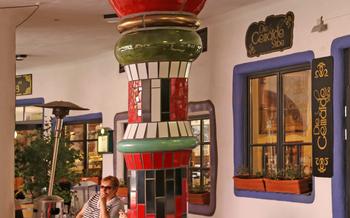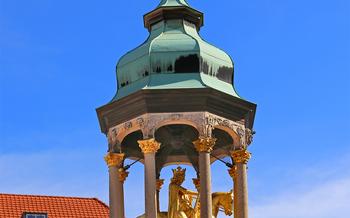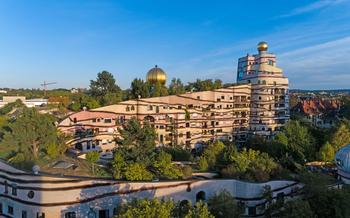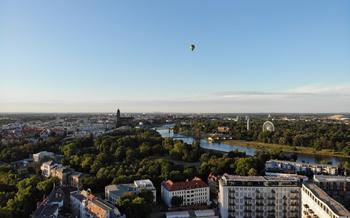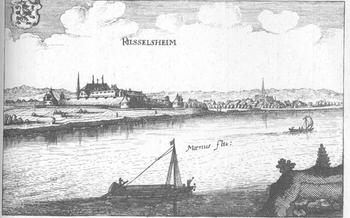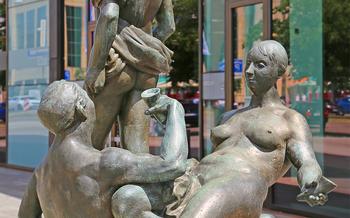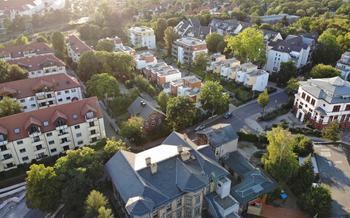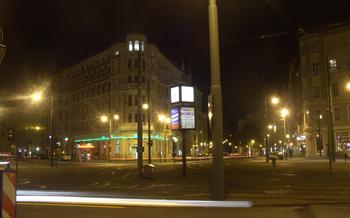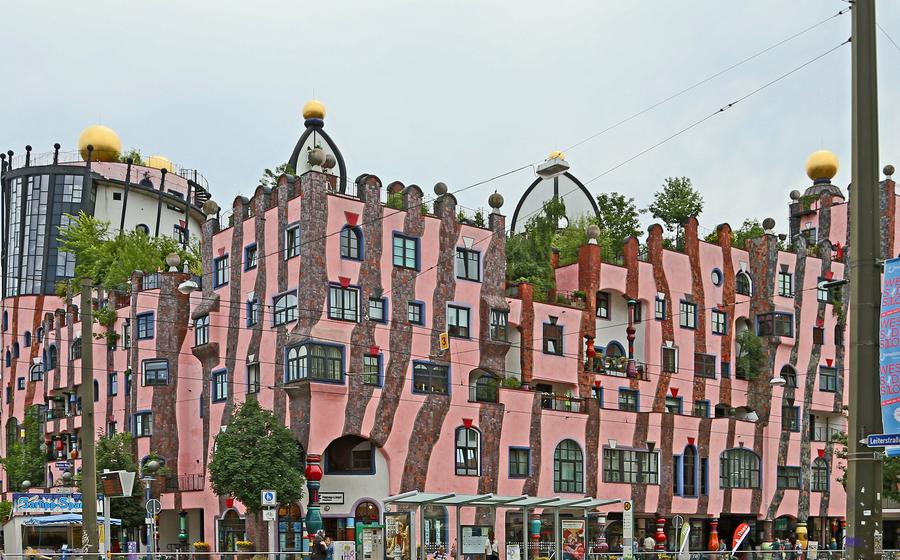
Die Grüne Zitadelle von Magdeburg
- A Monument to Sustainability and Art
- The Visionary Architect
- A Walk Through the Green Citadel
- The Golden Roof
- The Five Towers
- The Courtyard Oasis
- Sustainable Features
- Artistic Details
- Hundertwasser's Philosophy
- The Residents' Perspective
- Local Significance
- Guided Tours
- Visiting Tips
- Photography Opportunities
- Insider Tip: A Secret Garden Atop the Citadel
A Monument to Sustainability and Art
In the heart of Magdeburg, Germany, stands a captivating residential building that seamlessly blends art and sustainability: Die Grüne Zitadelle von Magdeburg, also known as the Green Citadel. Designed by the renowned Austrian artist and architect Friedensreich Hundertwasser, this architectural masterpiece is a testament to his unique vision of combining artistic expression with environmental responsibility.
Explore the Green Citadel's striking architecture, featuring undulating forms, colorful facades adorned with intricate mosaics, and lush gardens that intertwine with the building's structure. Discover the eco-friendly design elements, such as rainwater harvesting systems, solar panels, and recycled materials, that make this building a pioneer in sustainable living. Witness the harmonious fusion of art and sustainability as you marvel at this architectural wonder.
The Visionary Architect
The Green Citadel of Magdeburg owes its existence to the visionary architect Friedensreich Hundertwasser. Born in Vienna in 1928, Hundertwasser was a renowned artist and architect known for his unique and unconventional style. His artistic journey began with painting, but he soon ventured into architecture, driven by his desire to create buildings that harmonized with nature and reflected his artistic principles.
Hundertwasser's approach to architecture was deeply rooted in his commitment to environmentalism and sustainability. He believed that buildings should not only provide shelter but also serve as expressions of art and respect for the environment. This philosophy guided his designs, characterized by their organic forms, vibrant colors, and incorporation of natural elements.
Among Hundertwasser's most notable works are the Hundertwasserhaus in Vienna, the Waldspirale in Darmstadt, and the Rogner Bad Blumau in Styria, Austria. Each of these buildings showcases his unique style, with undulating facades, colorful mosaics, and unconventional shapes that blur the boundaries between art and architecture.
Hundertwasser's legacy extends far beyond his architectural creations. He was a prolific artist, producing numerous paintings, prints, and tapestries. His artistic style, characterized by bold colors, intricate patterns, and whimsical figures, has gained international recognition and continues to inspire artists worldwide.
A Walk Through the Green Citadel
Strolling through the Green Citadel is like stepping into a vibrant, whimsical world. The facade captivates with its colorful tiles, intricate mosaics, and playful patterns. It's a testament to Hundertwasser's belief that buildings should be works of art, not just structures. The lush gardens and courtyards, bursting with greenery, offer a sanctuary amidst the urban landscape. Trees, flowers, and plants of all kinds thrive in this oasis, creating a harmonious blend of architecture and nature.
Inside the building, each apartment is a unique masterpiece. The windows are adorned with colorful frames, and the walls are adorned with ceramic tiles and mosaics. The organic shapes and curved lines create a sense of fluidity and movement, making each space feel alive. The interiors are as vibrant and expressive as the exterior, reflecting Hundertwasser's commitment to creating living spaces that inspire and uplift.
Exploring the Green Citadel is a multisensory experience. The vibrant colors, intricate patterns, and natural elements come together to create a feast for the eyes. The building's unique architecture and artistic details invite visitors to look closer, discover hidden surprises, and appreciate the creativity and imagination poured into every corner.
The Golden Roof
The Green Citadel's golden roof is undoubtedly one of its most striking features. Composed of thousands of shimmering golden tiles, it reflects the sunlight, creating a captivating spectacle. Hundertwasser's choice of gold was not merely aesthetic; it held profound symbolic meaning. He saw gold as a representation of the sun, a symbol of life and energy. The golden roof, therefore, serves as a reminder of the importance of sunlight and solar power, emphasizing Hundertwasser's commitment to sustainability.
The creation of the golden roof was a meticulous process that required precision and craftsmanship. Each tile was carefully placed by hand, ensuring a seamless and lustrous finish. The result is a breathtaking canopy that commands attention and adds a touch of grandeur to the building.
The visual impact of the golden roof is undeniable. It transforms the Green Citadel into a beacon of light, visible from afar. It has become a distinctive landmark, synonymous with Hundertwasser's unique architectural style and his dedication to creating buildings that are both visually stunning and environmentally conscious.
The Five Towers
The Green Citadel is adorned with five distinctive towers, each boasting its own unique architectural style and design. The Tower of Individuality stands tall, representing the importance of embracing individuality and creativity. Its colorful facade and organic shape reflect Hundertwasser's belief in the power of self-expression. The Tower of Love symbolizes the strength of human connection and community. Its intricate mosaics and ceramic tiles depict scenes of love and unity, reminding visitors of the importance of human bonds. The Tower of Hope represents the architect's optimism for a better future. Its bright colors and upward-reaching form express his belief in the potential for positive change and transformation. The Golden Tower, with its gleaming exterior, serves as a symbol of prosperity and abundance. Its golden tiles reflect the sun's rays, creating a dazzling display that captivates the eye. Finally, the Tower of Knowledge represents the pursuit of wisdom and understanding. Its library houses a collection of books and resources on art, architecture, and sustainability, inviting visitors to explore and learn. Together, these five towers contribute to the overall beauty and significance of the Green Citadel, reflecting Hundertwasser's artistic vision and commitment to creating a truly unique and inspiring living space.
The Courtyard Oasis
In the heart of the Green Citadel, visitors are greeted by a serene sanctuary—the courtyard oasis. Designed to provide a tranquil respite from the bustling urban surroundings, the courtyard is a testament to Hundertwasser's love for nature and his ability to create harmonious spaces. Lush greenery, vibrant flowers, and carefully placed sculptures create a picturesque setting that invites visitors to unwind and soak in the beauty of the surroundings.
The courtyard's landscaping is a masterpiece in itself, featuring winding pathways that meander through sculpted hedges, colorful flower beds, and cascading waterfalls. The sound of trickling water adds a soothing ambiance, creating a peaceful atmosphere that is a welcome contrast to the city's hustle and bustle.
Benches and seating areas are strategically placed throughout the courtyard, allowing visitors to relax and take in the scenery. The courtyard also serves as a gathering place for residents, who come together to socialize, share stories, and enjoy the tranquility of this hidden gem.
The seamless blend of architecture and nature in the courtyard oasis is a testament to Hundertwasser's philosophy of creating living spaces that are both functional and aesthetically pleasing. This tranquil haven is a reminder of the importance of incorporating natural elements into urban environments, providing a much-needed oasis for both residents and visitors alike.
Sustainable Features
The Green Citadel stands as a testament to Hundertwasser's unwavering commitment to sustainability and environmental consciousness. The building boasts a plethora of innovative features that minimize its ecological footprint and promote a harmonious coexistence with nature. Recycled materials form the foundation of the structure, reducing the demand for virgin resources and diverting waste from landfills. Energy-efficient systems, including solar panels and geothermal heating, harness renewable energy sources, ensuring minimal reliance on fossil fuels. Rainwater harvesting systems capture and store rainwater for various purposes, such as irrigation and flushing toilets, reducing the strain on municipal water supplies. These eco-friendly features not only reduce the building's carbon emissions but also serve as a model for sustainable urban development, demonstrating that architectural innovation can go hand in hand with environmental responsibility.
Artistic Details
The Green Citadel is a visual masterpiece, adorned with intricate artistic details that reflect Hundertwasser's unique style and philosophy. Colorful mosaics, sculptures, and ceramic tiles cover the building's exterior and interior, creating a captivating and harmonious spectacle. Each piece of artwork tells a story, representing Hundertwasser's beliefs in individuality, creativity, and respect for nature.
The vibrant colors and organic forms of the mosaics evoke a sense of joy and optimism. The sculptures, often depicting human figures and animals, symbolize the interconnectedness of all living things. The ceramic tiles, with their intricate patterns and textures, add a touch of whimsy and playfulness to the building.
One of the most striking artistic elements is the "Tree of Life" mosaic, which adorns the facade of the building. This stunning artwork represents Hundertwasser's deep love for nature and his belief in the importance of preserving the environment. The tree, with its vibrant colors and intricate details, seems to come alive, symbolizing the interconnectedness of all living things and the vital role that nature plays in our lives.
The Green Citadel is a testament to Hundertwasser's artistic genius and his commitment to creating a building that is both aesthetically pleasing and environmentally sustainable. The intricate artistic details throughout the building invite visitors to explore, appreciate, and reflect on the power of art and the importance of living in harmony with nature.
Hundertwasser's Philosophy
Friedensreich Hundertwasser, the visionary architect behind the Green Citadel, was driven by a unique philosophy that shaped his artistic creations and architectural designs. At the core of his philosophy lay the belief in the importance of individuality and creativity. He rejected conformity and encouraged people to embrace their uniqueness, celebrating the diversity that makes each individual special.
Hundertwasser was a passionate advocate for environmental conservation and sustainability. He believed that humans have a responsibility to protect and preserve the natural world, and he incorporated these principles into his architectural designs. The Green Citadel exemplifies his commitment to sustainability, showcasing innovative features that minimize environmental impact while enhancing the living experience.
His philosophy is reflected throughout the Green Citadel, from the artistic details to the sustainable design features. The colorful mosaics, sculptures, and ceramic tiles that adorn the building are not merely decorative elements; they carry symbolic meanings and reflect Hundertwasser's beliefs about nature, harmony, and individuality.
By creating the Green Citadel, Hundertwasser sought to demonstrate that sustainability and aesthetics can coexist harmoniously. He believed that buildings should not only be functional but also works of art, inspiring and uplifting those who inhabit them. The Green Citadel stands as a testament to his philosophy, inviting visitors to experience a living canvas that celebrates creativity, sustainability, and the beauty of nature.
The Residents' Perspective
Living in the Green Citadel is an experience like no other. Residents enjoy a unique blend of art, sustainability, and community. They appreciate the building's stunning architecture, lush gardens, and innovative sustainable features. The colorful mosaics, sculptures, and ceramic tiles that adorn the building create a vibrant and stimulating living environment.
Residents also value the sense of community fostered by the unique design of the Green Citadel. The courtyard oasis provides a common space for gatherings, fostering social interaction and a strong sense of belonging. The shared commitment to sustainability further unites the residents, creating a supportive and eco-conscious community.
Despite its uniqueness, living in the Green Citadel comes with its own set of challenges. The building's intricate design can make it difficult to furnish and decorate apartments. Additionally, the high demand for living in such an iconic building means that apartments can be expensive.
Overall, the Green Citadel offers a truly unique and rewarding living experience. Residents are proud to call this architectural masterpiece home and appreciate the opportunity to live in a sustainable and artistic environment.
Local Significance
The Green Citadel is a source of pride and joy for the people of Magdeburg. It is a unique and iconic landmark that represents the city's commitment to sustainability, art, and innovation. The building has become a symbol of Magdeburg's transformation from a traditional industrial city to a modern, vibrant, and forward-looking urban center.
The Green Citadel attracts visitors from all over the world who come to admire its architectural beauty, learn about its sustainable features, and experience the unique atmosphere created by Hundertwasser's artistic vision. The building has also become a popular venue for events, exhibitions, and cultural gatherings, contributing to the city's rich cultural scene.
Locals appreciate the Green Citadel not only for its aesthetic value but also for its contribution to the city's green and sustainable initiatives. The building's innovative design and eco-friendly features serve as an inspiration for other sustainable development projects in Magdeburg. The Green Citadel demonstrates that it is possible to create beautiful and livable spaces while minimizing the environmental impact.
Overall, the Green Citadel holds a special place in the hearts of the people of Magdeburg. It is a symbol of the city's rich history, its commitment to sustainability, and its embrace of art and innovation.
Guided Tours
To delve deeper into the fascinating world of the Green Citadel, guided tours are available to provide an enriching experience. These tours offer visitors the opportunity to explore the building's unique features, learn about its history and architecture, and gain insights into Friedensreich Hundertwasser's artistic vision.
Various tour options are available, catering to different interests and time constraints. Standard guided tours typically last for about an hour and cover the highlights of the Green Citadel, including its exterior, interior, and courtyard. For a more in-depth experience, visitors can opt for extended tours that delve into the details of Hundertwasser's architectural philosophy and the sustainable features incorporated into the building.
During the tours, knowledgeable guides share fascinating stories and anecdotes about the Green Citadel, its creation, and its impact on Magdeburg. Visitors can ask questions, gain a deeper understanding of the building's significance, and appreciate the unique perspective it offers on architecture, art, and sustainability.
To ensure a spot on a guided tour, it is advisable to book in advance. Reservations can be made through the Green Citadel's website or by contacting the information desk. With a guided tour, visitors can maximize their experience and leave with a lasting impression of this architectural masterpiece.
Visiting Tips
For an unforgettable visit to the Green Citadel, plan your trip during the spring or summer months when the weather is pleasant, and the building's vibrant colors come alive. To avoid crowds, opt for a weekday visit or arrive early in the morning.
Before your visit, check the Green Citadel's official website for any special events, exhibitions, or guided tours that may be taking place. These events offer a deeper insight into Hundertwasser's work and the building's unique features.
To make the most of your visit, book a guided tour. Tours are available in various languages and provide a wealth of information about the building's history, architecture, and sustainability features.
After exploring the Green Citadel, take some time to wander around the surrounding area. The nearby Elbe River offers stunning views, and the city center is just a short walk away, where you can explore Magdeburg's other cultural attractions, such as the Magdeburg Cathedral and the Kulturhistorisches Museum Magdeburg.
For a complete experience, consider dining at one of the nearby restaurants. The Grüne Zitadelle Restaurant, located within the building, offers a unique dining experience with delicious local cuisine and stunning views of the Green Citadel.
Photography Opportunities
The Green Citadel is a photographer's paradise, offering unique angles and perspectives that make for stunning photographs. The vibrant colors, intricate details, and harmonious blend of architecture and nature create endless opportunities for capturing memorable shots. Whether you're an amateur or professional photographer, the Green Citadel will surely ignite your creativity. Recommended spots for capturing the best photos include the colorful facade, the lush gardens, the golden roof, and the courtyard oasis. Don't forget to share your beautiful shots using #GreenCitadelMagdeburg or #HundertwasserArchitecture to inspire others to visit this architectural masterpiece.
Insider Tip: A Secret Garden Atop the Citadel
Venture to the rooftop of the Green Citadel to discover a hidden gem – a secret garden oasis nestled among the building's unique architecture. This tranquil sanctuary offers breathtaking panoramic views of Magdeburg, creating a magical atmosphere for relaxation and contemplation. As you stroll through the lush greenery, admire the vibrant flowers, aromatic herbs, and whimsical sculptures that adorn this hidden paradise. It's the perfect spot to escape the city's hustle and bustle, soak in the beauty of nature, and gain a new perspective on this extraordinary building.
